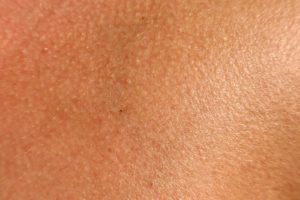 Did you know that you exchange some skin microbes with the person you live with? A recent study looked at the microbial communities on different regions of the skin of 10 heterosexual couples living together. The researchers found that cohabitation resulted in microbes being shared, but that a person's own microbes were more important, as well as their biological sex and what region of the skin was sampled. In other words - people's microbes look more like their own microbiome than that of their significant other.
Did you know that you exchange some skin microbes with the person you live with? A recent study looked at the microbial communities on different regions of the skin of 10 heterosexual couples living together. The researchers found that cohabitation resulted in microbes being shared, but that a person's own microbes were more important, as well as their biological sex and what region of the skin was sampled. In other words - people's microbes look more like their own microbiome than that of their significant other.
Skin is the largest organ of the body, and it is a protective barrier between a person and its environment. The skin contains a diverse microbial community of largely beneficial and benign microorganisms, and also protects the body from microorganisms with the potential to cause disease. Studies show that at least one million microbes (bacteria, fungi, viruses, archaea, etc.) occupy each square centimeter of skin. Humans shed over one million biological particles per hour.
The researchers also found that female skin microbial communities were more diverse than that of males, and that spending more time outdoors, owning pets, and drinking less alcohol (or none) were all associated with higher levels of microbial skin diversity. They found that a person's biological sex could be determined 100% of the time from microbes on the inner thigh skin. The skin of the feet had the most matched microbes among couples - perhaps when they walk barefoot on floors and the shower, they are sharing microbes (from skin particles that had been shed). From Science Daily:
Not under the skin, but on it: Living together brings couples' microbiomes together
Couples who live together share many things: Bedrooms, bathrooms, food, and even bacteria. After analyzing skin microbiomes from cohabitating couples, microbial ecologists at the University of Waterloo, in Canada, found that people who live together significantly influence the microbial communities on each other's skin. The commonalities were strong enough that computer algorithms could identify cohabitating couples with 86 percent accuracy based on skin microbiomes alone, the researchers report this week in mSystems, an open-access journal of the American Society for Microbiology.
However, the researchers also reported that cohabitation is likely less influential on a person's microbial profile than other factors like biological sex and what part of the body is being studied. In addition, the microbial profile from a person's body usually looks more like their own microbiome than like that of their significant other. "You look like yourself more than you look like your partner," says Ashley Ross, who led the study while a graduate student in the lab of Josh Neufeld.
Neufeld and Ross, together with Andrew Doxey, analyzed 330 skin swabs collected from 17 sites on the participants, all of whom were heterosexual and lived in the Waterloo region. Participants self-collected samples with swabs, and sites included the upper eyelids, outer nostrils, inner nostrils, armpits, torso, back, navel, and palms of hands. Neufeld says the study is the first to identify regions of skin with the most similar microbiomes between partners. They found the strongest similarities on partners' feet. "In hindsight, it makes sense," says Neufeld. "You shower and walk on the same floor barefoot. This process likely serves as a form of microbial exchange with your partner, and also with your home itself."
The analyses revealed stronger correlations in some sites than in others. For example, microbial communities on the inner thigh were more similar among people of the same biological sex than between cohabiting partners. Computer algorithms could differentiate between men and women with 100 percent accuracy by analyzing inner thigh samples alone, suggesting that a person's biological sex can be determined based on that region, but not others. The researchers also found that the microbial profiles of sites on a person's left side -- like hands, eyelids, armpits, or nostrils -- strongly resemble those on their right side. Of all the swab sites, the least microbial diversity was found on either side of the outer nose. [Original study.]
